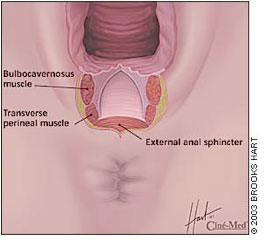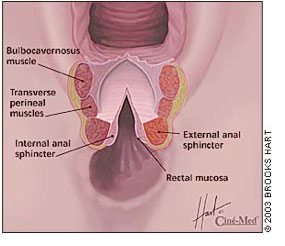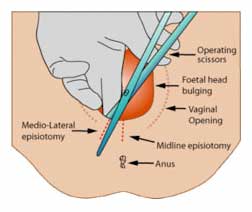The Perineum and Tears
Tears are common with vaginal delivery. As your baby makes her entrance into the world, you might end up with a tear in your perineum. Tears are more common with first vaginal deliveries and range from small nicks and abrasions to deep lacerations affecting several pelvic floor muscles. It’s possible to tear even if you have an episiotomy.

First degree tears are the most superficial tears involving the skin of the perineum, the tissue around the opening of the vagina and the outermost layer of the vagina itself (called the vaginal mucosa), but no muscle is involved. These tears often require no stitches, heal quickly and cause little discomfort.
Second-degree tears involve the skin, vaginal mucosa, and the muscles underneath. These tears need stitching layer by layer. They can be uncomfortable and take a few weeks to heal.
Third and Fourth degree tears are more serious tears. A third-degree tear involves the vaginal tissue, perineal skin, and the perineal muscles that extends into the anal sphincter (the muscle that surrounds your anus). A fourth-degree tear goes through the anal sphincter and the tissue underneath it.


Tears can happen to anyone, but risk factors include:
- Assisted delivery, particularly with forceps delivery
- Extension of an episiotomy
- A big baby
- Babies born face up (occipito-posterior)
- A short perineum: distance between vagina and anus
Tears in other places:
- Peri-urethral – tears at the top of the vagina near the urethra
- Upper vaginal tears-
- Labial tears- tears in the folds of skin just outside the vagina
Repairing tears – Perineal tears (or an episiotomy, or both) requires stitches for repair. Local anesthetic is used to numb the area. The tear is then repaired layer by layer.
Ice packs to the area and pain relief will help with discomfort afterwards.
Preventing tears – A slower, controlled delivery that allows time for stretching of your perineum as your baby comes through can reduce the risk of tearing. We cannot control everything and it is not always possible to prevent or avoid tears, particularly if your baby is big or in a difficult position or if you have fragile tissue.
Episiotomy
An episiotomy is a surgical cut made just before delivery in the muscular area between the vagina and the anus (the area called the perineum) to enlarge your vaginal opening. Local anaesthetic is usually used before making this cut, and more is used when it is repaired.

Reasons for an episiotomy – Episiotomies are not routine practice, but may be necessary for your own or your baby’s well being:
- If your baby’s heart rate shows distress indicating she isn’t tolerating the last minutes of labour and needs to be delivered quickly.
- If your baby is very large and extra room to manipulate him so she can be delivered
- If extra room is needed when using forceps to help deliver your baby
- If your tissue is starting to bleed or looks like it’s about to tear in multiple places as your baby’s head begins to crown. The idea here is that being cut in one place may allow you to avoid tearing in more than one place
Acknowledgements: www.babycenter.com

Our goal at Birthright is to provide you the best gynaecological care in a friendly and relaxed atmosphere, where you can talk to us about your needs.
Call us and discuss your care.
0800 247 848
